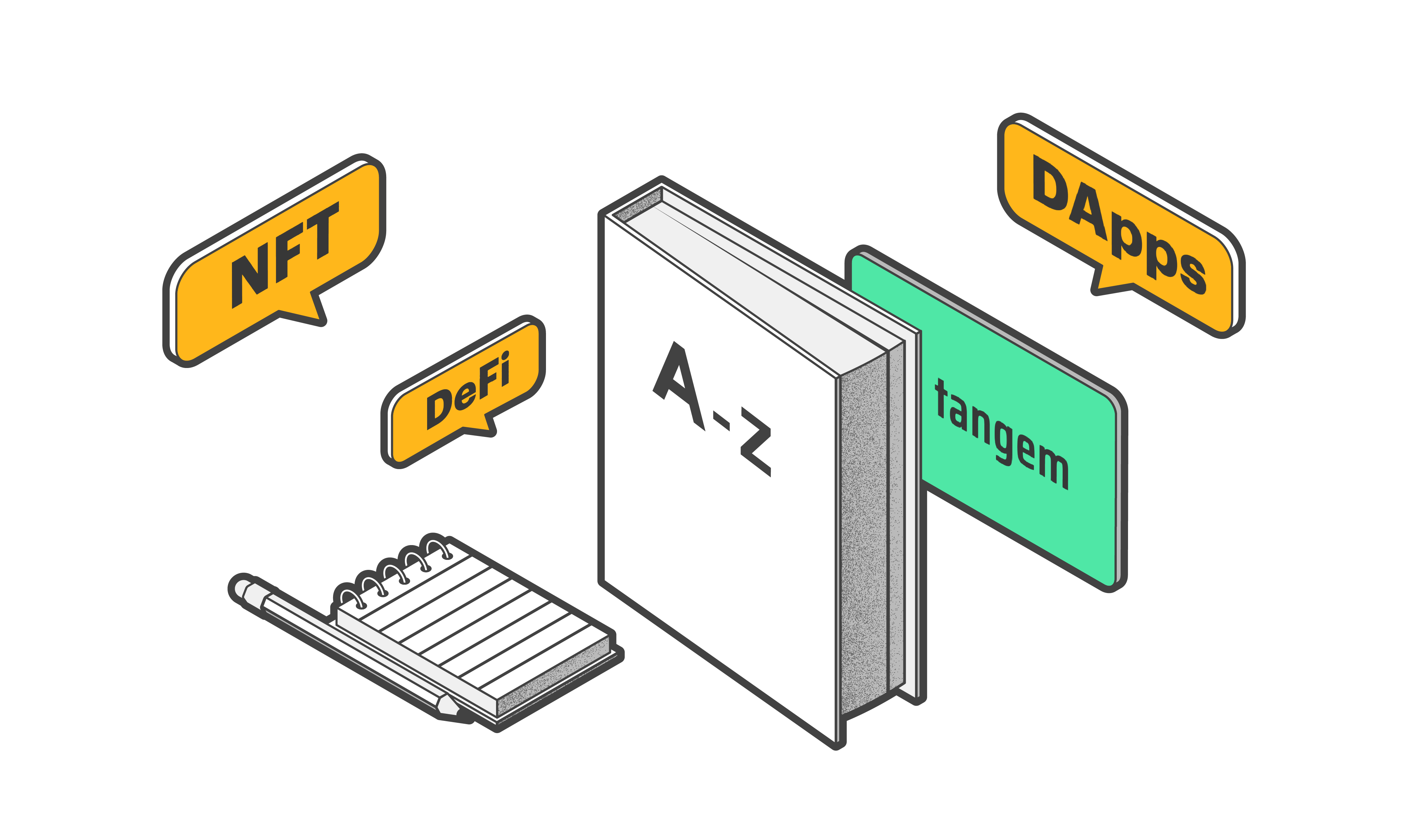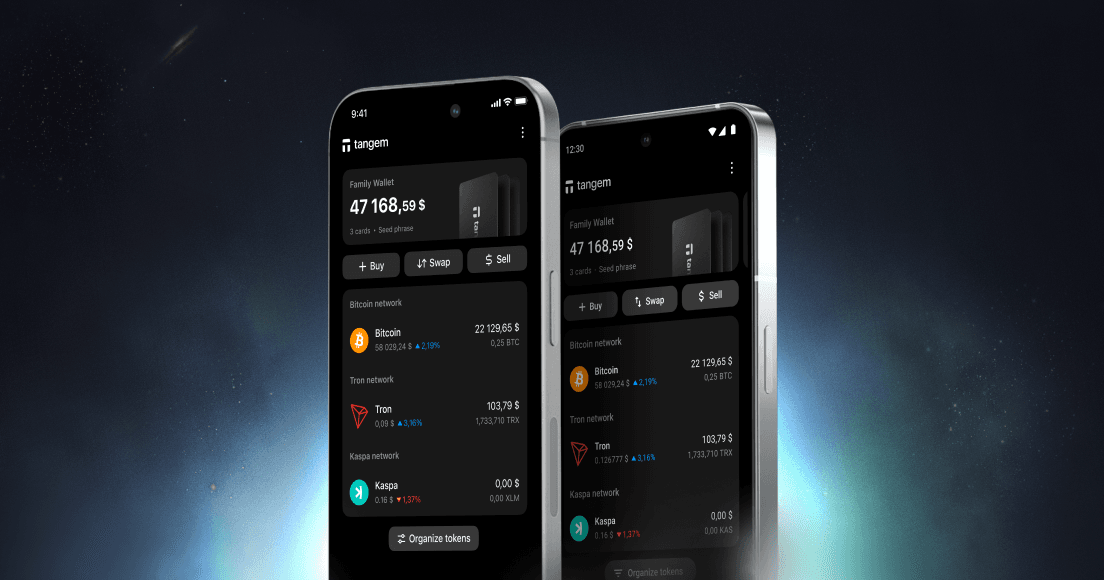
Tangem Glossary: Key Terms in Blockchain & Crypto Explained

A
Access code — Any word, phrase, number, or combination of alphanumeric characters that users choose to protect their Tangem Wallet from unauthorized third-party access.
Address — A unique combination of letters and numbers generated by a public key and used for sending and receiving cryptocurrency.
Affiliate — An affiliate is someone who promotes a project or product and earns a commission for driving traffic or sales.
Altcoin — An altcoin is any cryptocurrency other than Bitcoin. "Alt" stands for alternative, so these are alternative coins to Bitcoin. Examples include Ether, Ripple, and Litecoin.
AML — Anti-Money Laundering. It's a set of regulations and practices to prevent illegal financial activities, like money laundering and fraud.
API — Application Programming Interface. A set of rules that allows different software applications to communicate with each other.
Asset — An asset is basically anything valuable that you own or control with the expectation that it'll provide future benefits. It could be money, property, stocks, or cryptocurrency.
Asymmetric encryption — A system for encrypting data in which two keys linked by a mathematical algorithm are used for encryption and decryption. When applied to cryptocurrencies, a public (open) key is used to decrypt information, while a private (closed) key is used for encryption. Only the owner of a private key can encrypt data (transaction) so that it is decrypted (verified) by his public key.
B
Block — A set of transactions bundled together and added to the blockchain. Each block is linked to the previous one, forming a chain of blocks – hence the term "blockchain."
Blockchain — A decentralized database stored on thousands of computers worldwide. It is a continuous, consecutive chain of blocks in which all records of transactions are stored. Each new block contains data about the previous one.
Blockchain bridge — A protocol joining two blockchains with different economies and technologies (different consensus protocols, programming languages, and system rules) to ensure their compatibility. Blockchain bridges allow you to exchange coins belonging to different blockchains.
C
Card ID — A 16-digit alphanumeric code is found on every Tangem card. Example: AC11 0000 0003 9251
Co-branding — When two or more brands collaborate to create a product or service. It involves combining their logos and identities on a shared offering. For example, Tangem's co-branded wallets.
Cold wallet — An autonomous crypto wallet that is not connected to the internet and only goes online when it connects to a personal computer or smartphone to carry out a transaction.
Consensus — A set of rules by which the blocks in a blockchain are generated. Ensures that illegitimate alterations cannot be made to the blockchain.
Cross-chain swaps — exchanging cryptocurrencies between different blockchain networks. It allows users to trade or transfer assets that exist on one blockchain to another without relying on a centralized intermediary.
Cryptographic hash function — A mathematical algorithm used to create a unique digital imprint (hash) of original information. Used to protect information from unsanctioned alterations.
Crypto wallet — A program or device that generates and stores your private and public keys, allowing you to manage your crypto assets in the blockchain. A crypto wallet is also an address in the blockchain.
Custodial wallet — A crypto wallet whose private keys are held by a third party, for example, an exchange that manages it on your behalf.
D
dApps (decentralized applications) — smart contract-based programs that run on the blockchain. Used in various spheres: games, finances, social networks, etc.
DeFi (Decentralized Finance) — An ecosystem of financial applications that operate on the blockchain.
E
EAL6+ — Evaluation Assurance Level 6 with augmentation. It's a security assurance level used in the Common Criteria, a framework for evaluating and certifying the security features of information technology products. It indicates a high level of security design and implementation, often required for critical systems like government or military applications.
EVM (Ethereum Virtual Machine) — The basic mechanism responsible for executing smart contracts on the Ethereum network. EVM can also be characterized as a programming environment that allows developers to create decentralized apps (DApps) on the Ethereum blockchain with the help of smart contracts.
F
Factory reset — a factory reset wipes out all user data and settings, restoring the device to its original state when it left the factory. Be sure to transfer all assets out of your wallet before initiating the factory reset process.
Farming — passive income created by depositing coins/tokens to liquidity pools on DeFi platforms, where they can be lent to other market participants.
Fiat currency (fiat) — state-controlled currency (dollar, euro, pounds, yen).
Firmware audit — A soundness check for the software that runs on hardware devices. It involves reviewing and analyzing the code in the firmware to ensure it's secure, free of vulnerabilities and meets compliance standards
H
Hard fork — a substantial modification to the algorithms and code of a blockchain. As a result, a network either switches to a new version of the blockchain or splits into two parallel networks. A hard fork is often used to release new cryptocurrencies.
Hot wallet — a crypto wallet that is connected to the internet and always accessible.
Hot non-custodial wallet — a crypto wallet where you control the private keys, but it stays online all the time. Examples include Metamask and Exodus.
I
IP68 — A standard that rates the degree of protection against dust and water. If a device is IP68-rated, it's totally dust-tight and can handle immersion in water beyond 1 meter for a certain period.
Import — To move your assets and data from one wallet to another, often via a seed phrase.
Input — The source of coins for a given transaction, usually from the output of a preceding incoming transaction.
ISO — The International Organization for Standardization. It's a global body that develops and publishes standards to ensure product, service, and system quality, safety, and efficiency.
K
KYC procedure (Know Your Customer/Client) — a process for verifying user identity. It involves collecting and assessing information about users to ensure they are who they claim to be.
L
Liquidity — the ability of a coin/token to be quickly and easily converted into another crypto asset or fiat currency.
Liquidity pool — a pool of funds stored in a smart contract on a DeFi platform. Users contribute their assets to the pool to provide liquidity. In return, they earn fees for facilitating trades.
M
Mainnet — The main blockchain network where actual transactions and operations take place. It's the live and operational version of a blockchain, unlike a testnet or other development environments.
Memecoin — A cryptocurrency that gains value or popularity based on internet memes or social media trends rather than traditional factors like technology or utility.
Miner — A person who uses powerful computing equipment to check transactions for legitimacy and adds them to the blockchain for a reward, working on the PoW (Proof-of-Work) consensus model.
Mining difficulty — A blockchain parameter that measures the difficulty of solving a mathematical problem to create a new block. The difficulty varies in proportion to the total processing power of the network (the hash rate).
N
Network Commission — A fee for making a transaction, charged by a blockchain protocol and transferred to the miners/validators who generate new blocks in the blockchain by recording and confirming transactions on the network.
NFT (non-fungible tokens) — A record in the blockchain showing that you are the owner of a unique object in digital space (a picture, a meme, music, a film, a post, an artifact in a game, etc.).
Node — A server, personal computer, or laptop with special software connected to the blockchain network. A node’s main tasks are to generate new blocks for a blockchain, verify and confirm transactions, and store copies of data from the blockchain.
A non-custodial wallet — A crypto wallet whose private keys are held by you. Only you can access and manage them.
O
Off-ramp — Converting digital assets from a blockchain to another platform or traditional currency.
On-ramp — A service that allows you to convert traditional currency (fiat) into cryptocurrency.
Open source — A type of software or project where the source code is made available to the public, allowing anyone to view, modify, and distribute the code.
Order — An instruction for selling or purchasing coins/tokens on an exchange at either the current or a specific rate.
P
Private key — A randomly generated sequence of numbers used to create a digital signature for outgoing transactions. Accessible only to you.
Protocol — A set of rules governing data transfer on a blockchain, ensuring the immutability of transactions on the network.
Public key — a set of randomly generated letters and numbers used to verify the legitimacy of a transaction. Accessible to everyone.
R
Ring — Refers to Tangem Ring.
S
Seedless —A wallet or system that doesn't rely on a seed phrase for private key generation.
Seed phrase — A seed phrase is a set of words (usually 12 or 24) that act as a backup to recover your wallet if you lose access.
Smart contract — A digital equivalent to a regular contract, a program code integrated into the blockchain that allows you to set up transactions and control their execution using mathematical algorithms. If the agreements in the smart contract are fulfilled, a specified sequence of actions is automatically launched.
Soft fork — a change in the blockchain protocol resulting in the appearance of two parallel versions of the protocol, i.e., all nodes in the blockchain operate within a single network, but part of them function to old rules, part of them to new rules.
Stablecoin — A stable cryptocurrency whose price is pegged to another asset, generally in fiat currency.
Staking — Staking involves locking up a certain amount in a blockchain network to support its operations. In return, you earn rewards —more coins or tokens.
T
Token — A cryptocurrency without a blockchain that works on other blockchains based on smart contracts.
Transaction — an operation in which cryptocurrency or other information is transferred from one address to another, with the data recorded on the blockchain.
U
UTXO — Unspent Transaction Output. In blockchain, it represents the output of a transaction that hasn't been spent yet and can be used as input in a new transaction.
V
Validator — A cryptocurrency holder who, for a fee, blocks coins in a wallet and, using a computer with special software that is constantly connected to the internet, validates transactions and adds them to the blockchain, working on the PoS (Proof-of-Stake) consensus model.
Volatility — The fluctuation of the price of cryptocurrency over a certain period of time. The greater the fluctuation in the rate of the crypto asset, the higher its volatility.
W
WalletConnect — An open-source protocol that facilitates secure communication between decentralized applications (DApps) and crypto wallets.









